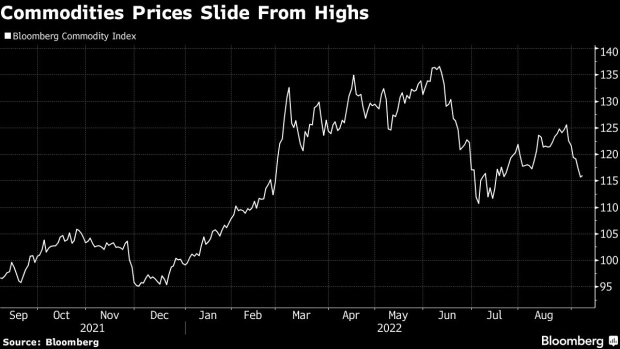Sep 8, 2022
Weak Yuan Is Latest Headache for China’s Commodities Importers
, Bloomberg News

(Bloomberg) -- Add the rapid drop in the value of the yuan to the litany of challenges facing global commodities prices.
China, the biggest importer of many raw materials, has already seen demand slacken as virus curbs, a property crisis and power outages over the summer hammered economic activity. And while higher energy costs due to the war in Europe are keeping global prices buoyant, consumption is falling as the world economy slows.
Like the rest of the planet, China typically buys raw materials in dollars, the world’s reserve currency. So the weakening in the yuan to 7 or more to the greenback piles on the costs for importers, depressing demand and forcing prices lower.
It’s a headwind for commodities where China is the biggest buyer, such as crude oil or copper; and even more so in markets where its importers account for the bulk of demand, like iron ore or soybeans.
The immediate impact of a cheaper yuan should be modest because much of China’s purchases are made via long-term deals, said Jia Zheng, head of commodity trading and research at Shanghai Dongwu Jiuying Investment Management Co. But a longer period of weakness will affect future contracts, and in the meantime send a chill through the spot markets that China uses to top up its needs, she said.
The Chinese currency has fallen around 3% against the dollar over the past month as losses accelerated, and is down more than 8% this year.
The falling yuan could also be a problem for commodities financing, in cases where Chinese traders have borrowed in dollars to make their purchases and will now be left with elevated funding costs.
For some markets, the circumstances will be pressing enough to force importers to absorb their currency costs no matter what, a task made easier when state-owned firms are doing the buying.
Natural gas traders, for example, won’t be deterred from procuring more fuel if the government orders them to ensure that winter heating requirements are met. Power plants could be in the same situation, given that demand for high-calorie coal exceeds local production.
The close ties that Beijing enjoys with Moscow can also deliver discounted rates across a raft of energy products, from oil to gas and coal, and the possibility of avoiding the dollar altogether by transacting in rubles or yuan.
Export Lift
Chinese exporters, meanwhile, should get a lift from a weaker currency, although there are fewer areas where they’re a dominant supplier to the rest of the world. But examples include aluminum, rare earths -- used in magnets, electronics and weapons -- and clean energy, especially solar panels.
More broadly, China’s vast array of manufacturers that fashion materials into finished goods for export should also benefit, potentially lifting domestic demand -- and prices -- for items like metals or cotton. And oil refiners that have taken a hit buying barrels in dollars could also look to make their money back by exporting more goods like plastics.
That makes the net impact of a weaker yuan on China’s economy more difficult to quantify.
“It will be a boon for export-focused companies that would stand to gain by shipping more finished products, whereas importers will face a rise in raw material costs,” said Chaohui Guo, an analyst at Beijing-based investment bank China International Capital Corp. “It’s hard to really say who is the winner and who is the loser.”
(Updates with size of yuan’s drop in 6th paragraph.)
©2022 Bloomberg L.P.






